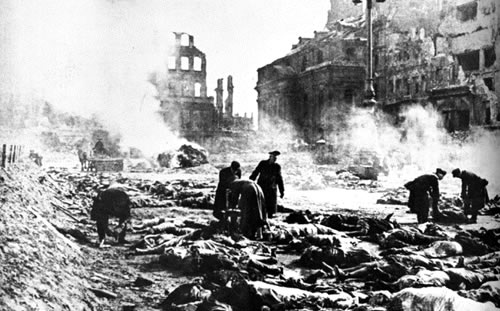 “You guys burnt the place down, turned it into a single column of flame. More people died there in the firestorm, in that one big flame, than died in Hiroshima and Nagasaki combined.” –Kurt Vonnegut, Jr
“You guys burnt the place down, turned it into a single column of flame. More people died there in the firestorm, in that one big flame, than died in Hiroshima and Nagasaki combined.” –Kurt Vonnegut, Jr
On the evening of February 13, 1945, an orgy of genocide and barbarism began against a defenseless German city, one of the greatest cultural centers of northern Europe. Within less than 14 hours not only was it reduced to flaming ruins, but an estimated one-third of its inhabitants, possibly as many as a half a million, had perished in what was the worst single event massacre of all time.
Toward the end of World War II, as Allied planes rained death and destruction over Germany, the old Saxon city of Dresden lay like an island of tranquillity amid desolation. Famous as a cultural center and possessing no military value, Dresden had been spared the terror that descended from the skies over the rest of the country.
In fact, little had been done to provide the ancient city of artists and craftsmen with anti-aircraft defenses. One squadron of planes had been stationed in Dresden for awhile, but the Luftwaffe decided to move the aircraft to another area where they would be of use. A gentlemen’s agreement seemed to prevail, designating Dresden an “open city.”
February 13/14 1945: Holocaust over Dresden, known as the Florence of the North. Dresden was a hospital city for wounded soldiers. Not one military unit, not one anti-aircraft battery was deployed in the city. Together with the 600.000 refugees from Breslau, Dresden was filled with nearly 1.2 million people. Churchill had asked for “suggestions how to blaze 600.000 refugees”. He wasn’t interested how to target military installations 60 miles outside of Dresden. More than 700.000 phosphorus bombs were dropped on 1.2 million people. One bomb for every 2 people. The temperature in the centre of the city reached 1600 o centigrade. More than 260.000 bodies and residues of bodies were counted. But those who perished in the centre of the city can’t be traced. Approximately 500.000 children, women, the elderly, wounded soldiers and the animals of the zoo were slaughtered in one night.
On Shrove Tuesday, February 13, 1945, a flood of refugees fleeing the Red Army 60 miles away had swollen the city’s population to well over a million. Each new refugee brought fearful accounts of Soviet atrocities. Little did those refugees retreating from the Red terror imagine that they were about to die in a horror worse than anything Stalin could devise.
Normally, a carnival atmosphere prevailed in Dresden on Shrove Tuesday. In 1945, however, the outlook was rather dismal. Houses everywhere overflowed with refugees, and thousands were forced to camp out in the streets shivering in the bitter cold.
However, the people felt relatively safe; and although the mood was grim, the circus played to a full house that night as thousands came to forget for a moment the horrors of war. Bands of little girls paraded about in carnival dress in an effort to bolster warning spirits. Half-sad smiles greeted the laughing girls, but spirits were lifted.
No one realized that in less than 24 hours those same innocent children would die screaming in Churchill’s firestorms. But, of course, no one could know that then. The Russians, to be sure, were savages, but at least the Americans and British were “honorable.”
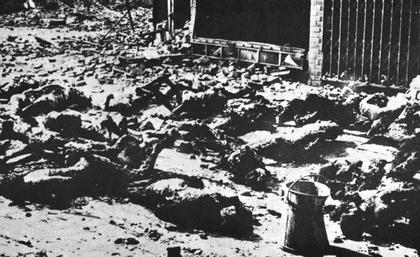 So, when those first alarms signaled the start of 14 hours of hell, Dresden’s people streamed dutifully into their shelters. But they did so without much enthusiasm, believing the alarms to be false, since their city had never been threatened from the air. Many would never come out alive, for that “great democratic statesman,” Winston Churchill–in collusion with that other “great democratic statesman,” Franklin Delano Roosevelt–had decided that the city of Dresden was to be obliterated by saturation bombing.
So, when those first alarms signaled the start of 14 hours of hell, Dresden’s people streamed dutifully into their shelters. But they did so without much enthusiasm, believing the alarms to be false, since their city had never been threatened from the air. Many would never come out alive, for that “great democratic statesman,” Winston Churchill–in collusion with that other “great democratic statesman,” Franklin Delano Roosevelt–had decided that the city of Dresden was to be obliterated by saturation bombing.
What where Churchill’s motives? They appear to have been political, rather than military. Historians unanimously agree that Dresden had no military value. What industry it did have produced only cigarettes and china.
But the Yalta Conference was coming up, in which the Soviets and their Western allies would sit down like ghouls to carve up the shattered corpse of Europe. Churchill wanted a trump card–a devastating “thunderclap of Anglo-American annihilation”–with which to “impress” Stalin.
That card, however, was never played at Yalta, because bad weather delayed the originally scheduled raid. Yet Churchill insisted that the raid be carried out–to “disrupt and confuse” the German civilian population behind the lines.
Dresden’s citizens barely had time to reach their shelters. The first bomb fell at 10:09 p.m. The attack lasted 24 minutes, leaving the inner city a raging sea of fire. “Precision saturation bombing” had created the desired firestorm.
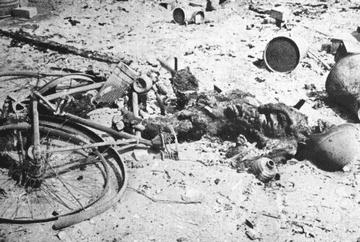 A firestorm is caused when hundreds of smaller fires join in one vast conflagration. Huge masses of air are sucked in to feed the inferno, causing an artificial tornado. Those persons unlucky enough to be caught in the rush of wind are hurled down entire streets into the flames. Those who seek refuge underground often suffocate as oxygen is pulled from the air to feed the blaze, or they perish in a blast of white heat–heat intense enough to melt human flesh.
A firestorm is caused when hundreds of smaller fires join in one vast conflagration. Huge masses of air are sucked in to feed the inferno, causing an artificial tornado. Those persons unlucky enough to be caught in the rush of wind are hurled down entire streets into the flames. Those who seek refuge underground often suffocate as oxygen is pulled from the air to feed the blaze, or they perish in a blast of white heat–heat intense enough to melt human flesh.
One eyewitness who survived told of seeing “young women carrying babies running up and down the streets, their dresses and hair on fire, screaming until they fell down, or the collapsing buildings fell on top of them.”
There was a three-hour pause between the first and second raids. The lull had been calculated to lure civilians from their shelters into the open again. To escape the flames, tens of thousands of civilians had crowded into the Grosser Garten, a magnificent park nearly one and a half miles square.
The second raid came at 1:22 a.m. with no warning. Twice as many bombers returned with a massive load of incendiary bombs. The second wave was designed to spread the raging firestorm into the Grosser Garten.
It was a complete “success.” Within a few minutes a sheet of flame ripped across the grass, uprooting trees and littering the branches of others with everything from bicycles to human limbs. For days afterward, they remained bizarrely strewn about as grim reminders of Allied sadism.
At the start of the second air assault, many were still huddled in tunnels and cellars, waiting for the fires of the first attack to die down. At 1:30 a.m. an ominous rumble reached the ears of the commander of a Labor Service convoy sent into the city on a rescue mission. He described it this way:
“The detonation shook the cellar walls. The sound of the explosions mingled with a new, stranger sound which seemed to come closer and closer, the sound of a thundering waterfall; it was the sound of the mighty tornado howling in the inner city.”
MELTING HUMAN FLESH
Others hiding below ground died. But they died painlessly–they simply glowed bright orange and blue in the darkness. As the heat intensified, they either disintegrated into cinders or melted into a thick liquid–often three or four feet deep in spots.
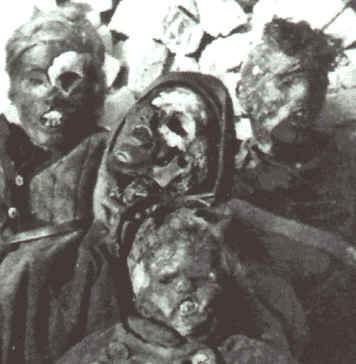 Shortly after 10:30 on the morning of February 14, the last raid swept over the city. American bombers pounded the rubble that had been Dresden for a steady 38 minutes. But this attack was not nearly as heavy as the first two.
Shortly after 10:30 on the morning of February 14, the last raid swept over the city. American bombers pounded the rubble that had been Dresden for a steady 38 minutes. But this attack was not nearly as heavy as the first two.
However, what distinguished this raid was the cold-blooded ruthlessness with which it was carried out. U.S. Mustangs appeared low over the city, strafing anything that moved, including a column of rescue vehicles rushing to the city to evacuate survivors. One assault was aimed at the banks of the Elbe River, where refugees had huddled during the horrible night.
In the last year of the war, Dresden had become a hospital town. During the previous night’s massacre, heroic nurses had dragged thousands of crippled patients to the Elbe. The low-flying Mustangs machine-gunned those helpless patients, as well as thousands of old men, women and children who had escaped the city.
When the last plane left the sky, Dresden was a scorched ruin, its blackened streets filled with corpses. The city was spared no horror. A flock of vultures escaped from the zoo and fattened on the carnage. Rats swarmed over the piles of corpses.
A Swiss citizen described his visit to Dresden two weeks after the raid: “I could see torn-off arms and legs, mutilated torsos and heads which had been wrenched from their bodies and rolled away. In places the corpses were still lying so densely that I had to clear a path through them in order not to tread on arms and legs.”
****************
Kurt Vonnegut was in Dresden when it was bombed in 1945, and wrote a famous anti-war novel, Slaughterhouse Five, in 1969.
In February 1945, Vonnegut was witness to another pretty good imitation of Mt Vesuvius; the firebombing by Allied forces of Dresden, the town in eastern Germany, during the last months of the Second World War. More than 600,000 incen-diary bombs later, the city looked more like the surface of the moon. Returning home to Indianapolis after the war, Vonnegut began writing short stories for magazines such as Collier’s and The Saturday Evening Post, and, seven years later, published his first novel, Player Piano. …
Finally, in 1969, he tackled the subject of war, recounting his experiences as a POW in Dresden, forced to dig corpses from the rubble. The resulting novel was Slaughterhouse Five. Banned in several US states – and branded a “tool of the devil” in North Dakota – it carried the snappy alternative title: “The Children’s Crusade: A Duly Dance with Death, by Kurt Vonnegut, Jr, a fourth-generation German-American now living in easy circumstances on Cape Cod (and smoking too much) who, as an American infantry scout hors de combat, as a prisoner of war, witnessed the fire bombing of Dresden, Germany – the Florence of the Elbe – a long time ago, and survived to tell the tale: this is a novel somewhat in the telegraphic schizopfrenic manner of tales of the planet Tralfamodre, where the flying saucers come from, Peace.” ….
In December 1944, Vonnegut was captured by the German army and became a prisoner of war. In Slaughterhouse Five, he describes how he narrowly escaped death a few months later in the firebombing of Dresden. “Yes, by your people [the English], may I say,” he insists. “You guys burnt the place down, turned it into a single column of flame. More people died there in the firestorm, in that one big flame, than died in Hiroshima and Nagasaki combined. I’m fond of your people, on occasion, but I was just thinking about ‘Bomber Harris, who believed in attacks on civilian populations to make them give up. A hell of a lot of Royal Air Force guys were ashamed of what Harris had made them do. And that’s really sportsmanship and, of course, the Brits are famous for being good sports,” he concedes.
The Independent, London, 20 December 2001, p. 19
***************
The death toll was staggering. The full extent of the Dresden Holocaust can be more readily grasped if one considers that well over 250,000 — possibly as many as a half a million — persons died within a 14-hour period, whereas estimates of those who died at Hiroshima range from 90,000 to 140,000.*
Allied apologists for the massacre have often “twinned” Dresden with the English city of Coventry. But the 380 killed in Coventry during the entire war cannot begin to compare with over 1,000 times that number who were slaughtered in 14 hours at Dresden. Moreover, Coventry was a munitions center, a legitimate military target. Dresden, on the other hand, produced only china–and cups and saucers can hardly be considered military hardware!
It is interesting to further compare the respective damage to London and Dresden, especially when we recall all the Hollywood schmaltz about the “London blitz.” In one night, 1,600 acres of land were destroyed in the Dresden massacre. London escaped with damage to only 600 acres during the entire war.
In one ironic note, Dresden’s only conceivable military target — its railroad yards — was ignored by Allied bombers. They were too busy concentrating on helpless old men, women and children.
If ever there was a war crime, then certainly the Dresden Holocaust ranks as the most sordid one of all time. Yet there are no movies made today condemning this fiendish slaughter; nor did any Allied airman–or Sir Winston–sit in the dock at Nuremberg. In fact, the Dresden airmen were actually awarded medals for their role in this mass murder. But, of course, they could not have been tried, because there were “only following orders.”
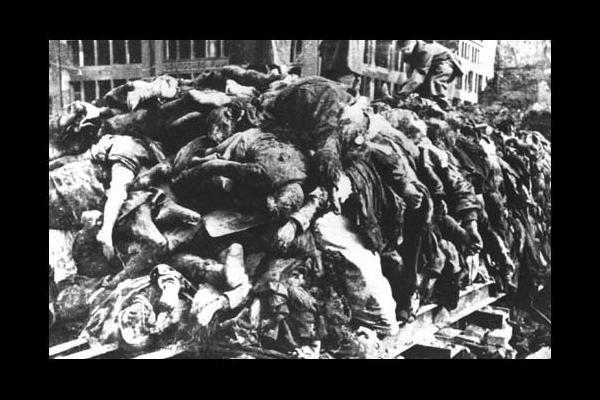
This is not to say that the mountains of corpses left in Dresden were ignored by the Nuremberg Tribunal. In one final irony, the prosecution presented photographs of the Dresden dead as “evidence” of alleged National Socialist atrocities against Jewish concentration-camp inmates!
Churchill, the monster who ordered the Dresden slaughter, was knighted, and the rest is history. The cold-blooded sadism of the massacre, however, is brushed aside by his biographers, who still cannot bring themselves to tell how the desire of one madman to “impress” another one let to the mass murder of up to a half million men, women and children.



